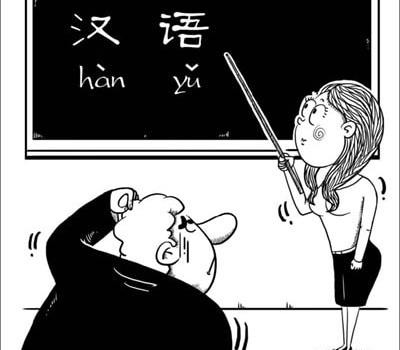If you’re struggling with your tones, there are a few things you can do (including reading this article!):
- You can check out the Written Chinese Tone Trainer. Click on the speaker button and then choose from the 5 tones below. The trainer will keep a score for you so you know how well you’re doing!
- If you’re online on your computer you can use the Online Dictionary. Just tap the ‘speaker’ button on the left side of a character and listen to the pronunciation (and tone) of the character.
The situation when “一” (yī) needs to be a changed tone
1. Before the 4th tone, “一” should be changed to 2nd tone(yí)
For example: 一样 (yí yàng),一下 (yí xià),一座 (yí zuò),一位 (yí weì),一次 (yí cì),一块 (yí kuài);
2. Before the 1st tone, 2nd tone and 3rd tone “一” should become 4th tone(yì)
For example: 一般 (yì bān),一年 (yì nián),一门 (yì mén),一起 (yì qǐ),一种 (yì zhǒng);
3. If “一” is between two verbs, it should be 5th tone
For example: 看一看 (kàn yi kàn),想一想 (xiǎng yi xiǎng),试一试 (shì yi shì).
4. If “一” is between a verb and a measure word or between an adjective and a measure word, generally it should also be the 5th tone
For example: 去一趟 (qù yi tàng),认识一下 (rèn shi yi xià),好一点 (hǎo yi diǎn)。
The situation when “不” (bù) needs to be changed tone
1. Before the 4th tone, “不” should be changed to 2nd tone
For example: 不要(bú yào),不错(bú cuò),不是(bú shì).
2. If it’s used as verb complement or used between two same words, it should become 5th tone
For example: 起不来 (qǐ bu lái),说不定 (shuō bu dìng),差不多 (chā bu duō),会不会 (huì bu huì),贵不贵 (guì bu guì).
The situation when 3rd-tone needs to be changed tone
If an entry’s tones are double 3rd-tones, the first tone needs to be changed to 2nd tone.
For example: The pinyin of “你好” that means “Hello” is “ní hǎo”; the original tones are “nǐ” and “hǎo” individually. The pinyin of “举手” which means “put your hands up” is “jú shǒu” the original tones are “jǔ” and “shǒu” individually.
I can give you more examples about this rule:
很 (hěn) 好 (hǎo): (hén hǎo) means very good.
理 (lǐ) 想 (xiǎng): (lí xiǎng) means dream.
处 (chǔ) 理 (lǐ): (chú lǐ) means deal with.
铁 (tiě) 桶 (tǒng): (tié tǒng) means metal bucket.
五(wǔ) 角 (jiǎo): (wú jiǎo) means fifty cents.
品 (pǐn) 种 (zhǒng): (pín zhǒng) means variety.
想 (xiǎng) 法(fǎ): (xiáng fǎ) means thought.
水 (shuǐ) 果 (guǒ): (shuí guǒ) means fruit.
If it’s a three or more 3rd-tone entry, the basic rule is that all the 3rd tones before the last 3rd tone need to be changed to 2nd tone. For example, the tone of “处 (chǔ) 理 (lǐ) 厂(chǎng)” which means treatment plant needs to become “chú lí chǎng”.
But sometimes, we need to analyze the structure of the word or sentence to pronounce correctly.
The pinyin of “打 (dǎ) 老 (lǎo) 鼠 (shǔ)”, which means hit the mouse, is “dǎ láo shǔ” because “打” is a verb and “老鼠” is a noun so they need to be pronounce separately. Therefore, “打” doesn’t need to be changed but “老鼠” will follow the basic rule so it should become “láo shǔ”.

However, the changing 3rd tone is a complicated case.
Here is the sentence:
我 (wǒ) 想 (xiǎng) 买 (mǎi) 五 (wǔ) 百 (bǎi) 把 (bǎ) 雨 (yǔ) 伞 (sǎn) that means ‘I want to buy 500 umbrellas.’
The tone for each character in this sentence is 3rd tone. As a native Chinese speaker, if I read it without any consideration about the changing 3rd tone rules, it will be:
我(wó) 想 (xiáng) 买 (mǎi) 五 (wú) 百 (bái) 把 (bǎ) 雨 (yú) 伞 (sǎn).
Actually it does not exactly follow the changing 3rd tone rules but it follows the rules if you separate the sentence into 3 parts like this:
So sometimes it depends on how you separate the word or sentence that will decide if the pronunciation is correct or not. After all, this sentence is a special case so I think it’s good enough for now to remember the basic rule: if it’s consecutive 3rd tone entry, all the 3rd tones before the last 3rd tone need to be changed to 2nd tone.
That’s what I know about changing tones in Mandarin. Hope you learn these and it’s helpful to improve your spoken Chinese! 加油加油!
